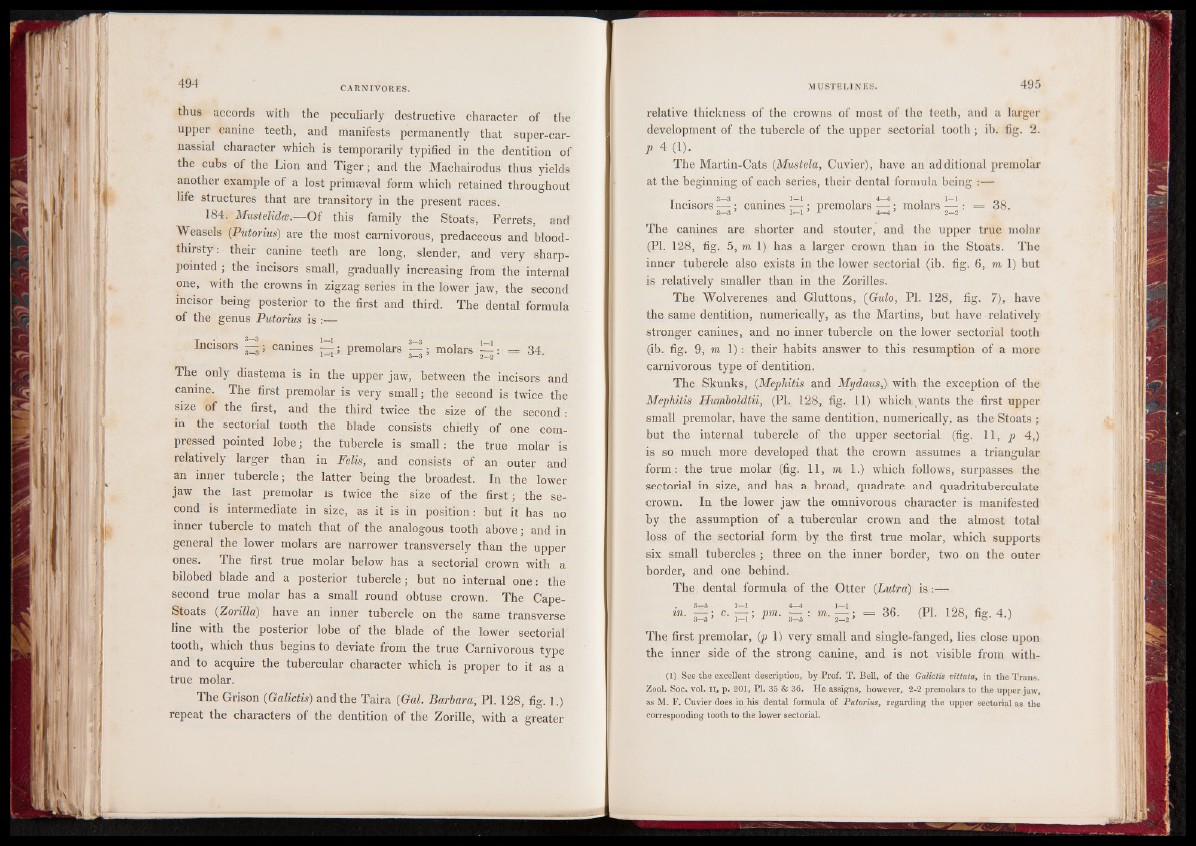
thus accords with the peculiarly destructive character of the
upper canine teeth, and manifests permanently that super-car-
nassial character which is temporarily typified in the dentition of
the cubs of the Lion and Tiger 1 and the Machairodus thus yields
another example of a lost primaeval form which retained throughout
life structures that are transitory in the present races.
184. Must elides.—Of this family the Stoats, Ferrets, and
Weasels (Putorius) are the most carnivorous, predaceous and bloodthirsty:
their canine teeth are long, slender, and very sharp-
pointed ; the incisors small, gradually increasing from the internal
one, with the crowns in zigzag series in the lower jaw, the second
incisor being posterior to the first and third. The dental formula
of the genus Putorius is 3—
Incisors — | canines ^ ; premolars ^ ; molars ^ : = 34.
The only diastema is in the upper jaw, between the incisors and
canine. The first premolar is very small; the second is twice the
size of the first, and the third twice the size of the second :
in the sectorial tooth the blade consists chiefly of one compressed
pointed lobe; the tubercle is small: the true molar is
relatively larger than in Felis, and consists of an outer and
an inner tubercle; the latter being the broadest. In the lower
jaw the last premolar is twice the size of the first; the second
is intermediate in size, as it is in position: but it has no
inner tubercle to match that of the analogous tooth above; and in
general the lower molars are narrower transversely than the upper
ones. The first true molar below has a sectorial crown with a
bilobed blade and a posterior tubercle; but no internal one: the
second true molar has a small round obtuse crown. The Cape-
Stoats (Zorilla) have an inner tubercle on the same transverse
line with the posterior lobe of the blade of the lower sectorial
tooth, which thus begins to deviate from the true Carnivorous type
and to acquire the tubercular character which is proper to it as a
true molar.
The Grison (Galictis) and the Taira (Gal. Barbara, PI. 128, fig. 1.)
repeat the characters of the dentition of the Zorille, with a greater
relative thickness of the crowns of most of the teeth, and a larger
development of the tubercle of the upper sectorial tooth; ib. fig. 2.
P 4 (1).
The Martin-Cats (Mustela, Cuvier), have an additional premolar
at the beginning of each series, their dental formula being :—
Incisors — ; canines. — ; premolars §tlf: molars — : = 38. 3—3 ’ I—1 9 r 4—4 9 , 2—2
The canines are shorter and stouter, and the upper true molar
(PI. 128, fig. 5, m 1) has a larger crown than in the Stoats. The
inner tubercle also exists in the lower sectorial (ib. fig. 6, m 1) but
is relatively smaller than in the Zorilles.
The Wolverenes and Gluttons, (Gulo, PL 128, fig. 7), have
the same dentition, numerically, as the Martins, but have relatively
stronger canines, and no inner tubercle on the lower sectorial tooth
(ib. fig. 9, m 1): their habits answer to this resumption of a more
carnivorous type of dentition.
The Skunks, (Mephitis and Mydaus,} with the exception of the
Mephitis Humboldtii, (PL 128, fig. 11) which wants the first upper
small premolar, have the same dentition, numerically, as the Stoats ;
but the internal tubercle of the upper sectorial (fig. 11, p 4,)
is so much more developed that the crown assumes a triangular
form: the true molar (fig. 11, m 1.) which follows, surpasses the
sectorial in size, and has a broad, quadrate and quadrituberculate
crown. In the lower jaw the omnivorous character is manifested
by the assumption of a tubercular crown and the almost total
loss of the sectorial form by the first true molar, which supports
six small tubercles ; three on the inner border, two on the outer
border, and one behind.
The dental formula of the Otter (Lutra) is :—
in- S ; c- IZi; Pm• iZJ : m- iEiJ == 36- (PI- 128, fig. 4.)
The first premolar, (p 1) very small and single-fanged, lies close upon
the inner side of the strong canine, and is not visible from with-
(1) See the excellent description, by Prof. T. Bell, of the Galictis vittata, in the Trans.
Zool. Soc. vol. ii, p. 201, PI. 35 & 36. He assigns, however, 2-2 premolars to the upper jaw,
as M. F. Cuvier does in his dental formula of Putorius, regarding the upper sectorial as the
corresponding tooth to the lower sectorial.